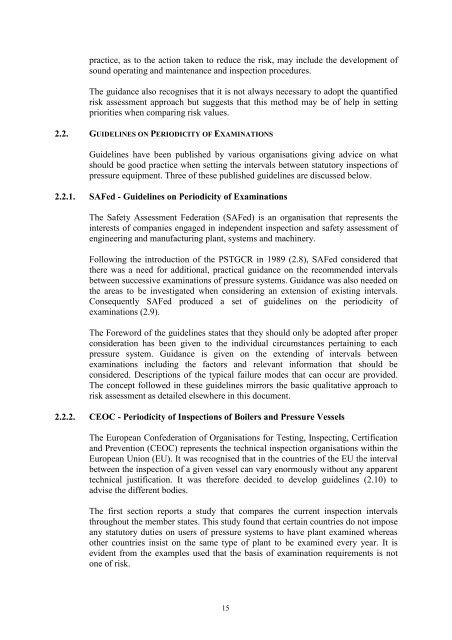Best Practice for Risk Based Inspection
risk based inspection
risk based inspection
Create successful ePaper yourself
Turn your PDF publications into a flip-book with our unique Google optimized e-Paper software.
practice, as to the action taken to reduce the risk, may include the development of<br />
sound operating and maintenance and inspection procedures.<br />
The guidance also recognises that it is not always necessary to adopt the quantified<br />
risk assessment approach but suggests that this method may be of help in setting<br />
priorities when comparing risk values.<br />
2.2. GUIDELINES ON PERIODICITY OF EXAMINATIONS<br />
Guidelines have been published by various organisations giving advice on what<br />
should be good practice when setting the intervals between statutory inspections of<br />
pressure equipment. Three of these published guidelines are discussed below.<br />
2.2.1. SAFed - Guidelines on Periodicity of Examinations<br />
The Safety Assessment Federation (SAFed) is an organisation that represents the<br />
interests of companies engaged in independent inspection and safety assessment of<br />
engineering and manufacturing plant, systems and machinery.<br />
Following the introduction of the PSTGCR in 1989 (2.8), SAFed considered that<br />
there was a need <strong>for</strong> additional, practical guidance on the recommended intervals<br />
between successive examinations of pressure systems. Guidance was also needed on<br />
the areas to be investigated when considering an extension of existing intervals.<br />
Consequently SAFed produced a set of guidelines on the periodicity of<br />
examinations (2.9).<br />
The Foreword of the guidelines states that they should only be adopted after proper<br />
consideration has been given to the individual circumstances pertaining to each<br />
pressure system. Guidance is given on the extending of intervals between<br />
examinations including the factors and relevant in<strong>for</strong>mation that should be<br />
considered. Descriptions of the typical failure modes that can occur are provided.<br />
The concept followed in these guidelines mirrors the basic qualitative approach to<br />
risk assessment as detailed elsewhere in this document.<br />
2.2.2. CEOC - Periodicity of <strong>Inspection</strong>s of Boilers and Pressure Vessels<br />
The European Confederation of Organisations <strong>for</strong> Testing, Inspecting, Certification<br />
and Prevention (CEOC) represents the technical inspection organisations within the<br />
European Union (EU). It was recognised that in the countries of the EU the interval<br />
between the inspection of a given vessel can vary enormously without any apparent<br />
technical justification. It was there<strong>for</strong>e decided to develop guidelines (2.10) to<br />
advise the different bodies.<br />
The first section reports a study that compares the current inspection intervals<br />
throughout the member states. This study found that certain countries do not impose<br />
any statutory duties on users of pressure systems to have plant examined whereas<br />
other countries insist on the same type of plant to be examined every year. It is<br />
evident from the examples used that the basis of examination requirements is not<br />
one of risk.<br />
15



